Blog
The Knee Massager Guide: Relief and Recovery for Active Lifestyles
Article Outline:
- Introduction to knee pain and the benefits of using a knee massager
- Understanding knee anatomy and common causes of knee pain
- How a knee massager works and the different types available ?
- The importance of proper knee alignment and posture
- The role of exercise and stretching in knee pain management
- How to choose the right knee massager for your needs?
- The benefits of using a knee massager for pre- and post-workout recovery
- How to use a knee massager for maximum effectiveness?
- The benefits of combining knee massagers with other treatments, such as physical therapy
- The potential risks and side effects of using a knee massager
- How to maintain and care for your knee massager?
- Tips for incorporating knee massagers into your daily routine
- The effectiveness of knee massagers for different knee conditions, such as osteoarthritis and patellofemoral pain syndrome
- Frequently asked questions about knee massagers
- Conclusion and the future of knee pain management through technology and innovation.
Introduction:
Knee pain can be debilitating, preventing you from enjoying the active lifestyle you once knew. Whether it’s from a sports injury, overuse, or simply aging, knee pain affects millions of people worldwide. While there are many traditional treatments available, such as physical therapy, pain medication, and surgery, a growing number of people are turning to a new solution: knee massagers.
Knee massagers are portable, easy to use devices that deliver targeted massage to the knee joint, helping to relieve pain and promote recovery. With so many options on the market, it can be overwhelming trying to find the right one for your needs. That’s why we’ve written “The Knee Massager Guide: Relief and Recovery for Active Lifestyles.”
In this article, you’ll learn everything you need to know about knee massagers, from how they work to the different types available, and how to choose the right one for you. We’ll also cover the benefits of using a knee massager for pre- and post-workout recovery, and how to incorporate them into your daily routine for maximum benefit.
So if you’re ready to take control of your knee pain and get back to living an active lifestyle, then read on!
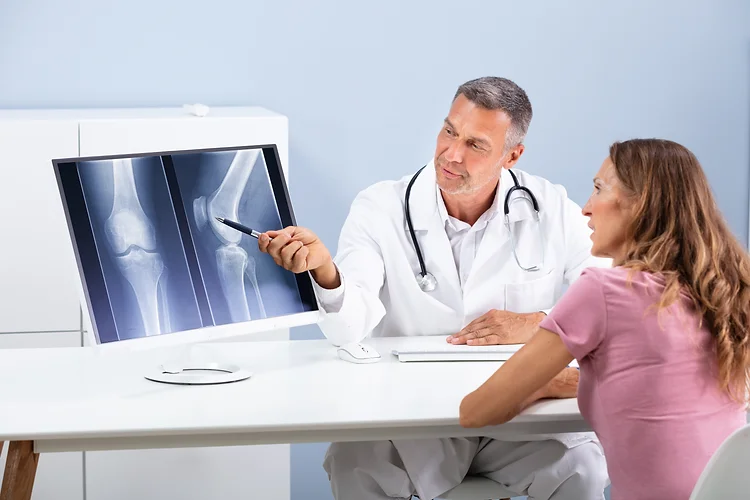
Chapter 1: Introduction to Knee Pain and the Benefits of Using a Knee Massager
Knee pain is a common problem that affects millions of people worldwide. It can be caused by a variety of factors, including sports injuries, overuse, and aging. In this chapter, we’ll introduce you to knee pain and its causes, and explain why using a knee massager can be an effective way to relieve pain and promote recovery.
We’ll also highlight the benefits of using a knee massager, including increased circulation, reduced muscle soreness, and improved joint mobility. Whether you’re an athlete, weekend warrior, or simply someone who wants to keep their knees healthy, this chapter will help you understand why a knee massager may be the right choice for you.
This chapter will give you a solid foundation in the world of knee pain and the benefits of using a knee massager. By the end of it, you’ll be ready to start exploring the different types of knee massagers available and how to choose the right one for your needs.
Knee pain is a common problem that affects millions of people worldwide. It can be caused by various factors such as arthritis, injury, or overuse. The knee is one of the most important joints in the body and is responsible for supporting our weight and helping us move. As a result, knee pain can have a significant impact on our daily lives, making it difficult to perform even the simplest tasks.
Fortunately, there are a number of treatments available to alleviate knee pain, one of which is the use of a knee massager. A knee massager is a device designed to help improve circulation, relieve pain, and reduce inflammation in the knee. In this article, we’ll explore the benefits of using a knee massager and how it can help manage knee pain.
The Benefits of Using a Knee Massager
- Pain Relief: A knee massager can help relieve pain and discomfort by increasing circulation and reducing inflammation in the knee. The massage function stimulates the nerve endings in the knee, providing a soothing and relaxing sensation.
- Improved Circulation: Improved circulation helps to reduce inflammation and improve the healing process in the knee. This can also help to speed up recovery after an injury or surgery.
- Increased Flexibility: The massage function of a knee massager can help to increase flexibility in the knee by loosening tight muscles and promoting movement. This can be particularly beneficial for those with arthritis or other conditions that cause stiffness in the knee.
- Reduced Swelling: Knee massagers can also help to reduce swelling and inflammation by improving circulation and draining excess fluid from the knee.
- Easy to Use: Knee massagers are easy to use and can be used at home, making them a convenient and accessible option for those who suffer from knee pain.
Conclusion
In conclusion, the use of a knee massager can provide a number of benefits for those suffering from knee pain. From relieving pain and discomfort to improving circulation and reducing inflammation, a knee massager is an effective and accessible option for managing knee pain.
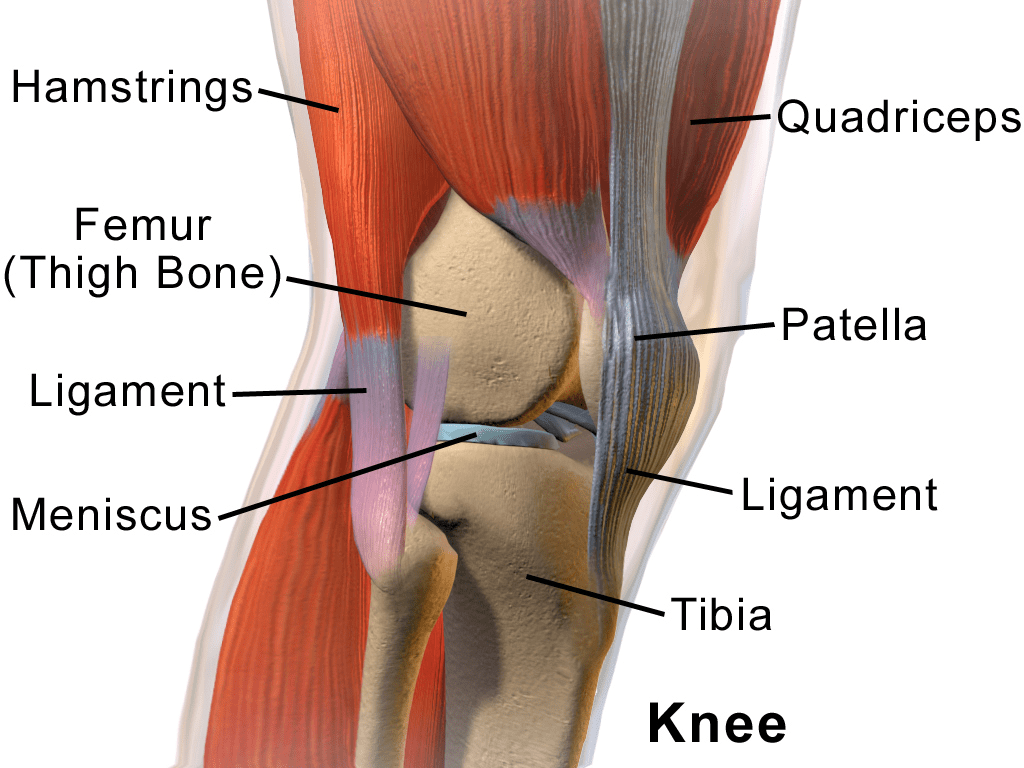
Chapter 2: Understanding Knee Anatomy and Common Causes of Knee Pain
In this chapter, we’ll delve into the anatomy of the knee joint and the various structures that make it up. We’ll also explore the most common causes of knee pain, including sports injuries, overuse, osteoarthritis, and patellofemoral pain syndrome.
By understanding the underlying causes of knee pain, you’ll be better equipped to make informed decisions about your treatment options. This chapter will also help you understand the importance of proper knee alignment and posture, and how these factors can impact knee health.
The knee is a complex joint in the human body that is responsible for supporting the weight of the body and facilitating movement. It is one of the largest and most important joints in the body, and is made up of bones, cartilage, ligaments, and tendons. In this article, we will take a closer look at the anatomy of the knee, and explore some of the most common causes of knee pain.
Knee Anatomy
The knee is composed of three bones: the thigh bone (femur), the shin bone (tibia), and the kneecap (patella). These bones are held together by a network of ligaments, which provide stability and support to the joint. The ends of the bones are covered with a layer of smooth, glistening cartilage, which helps to reduce friction and protect the bones from damage.
In addition to bones and cartilage, the knee is also made up of several other important structures, including the meniscus, bursae, and tendons. The meniscus is a piece of cartilage that helps to distribute the weight of the body evenly across the knee, while the bursae are small fluid-filled sacs that reduce friction and cushion the knee. The tendons connect the muscles of the thigh and lower leg to the bones of the knee, and help to control movement.
Common Causes of Knee Pain
There are many different factors that can contribute to knee pain, including injury, overuse, and degenerative conditions. Some of the most common causes of knee pain include:
- Osteoarthritis: Osteoarthritis is a degenerative condition that occurs when the cartilage in the knee wears away, causing pain and stiffness. This condition is more common in older individuals, but can occur at any age.
- Meniscus tears: The meniscus can become damaged due to injury or overuse, leading to pain and swelling in the knee.
- Sprains and strains: Sprains and strains occur when the ligaments or tendons in the knee become stretched or torn, causing pain and instability.
- Bursitis: Bursitis occurs when the bursae in the knee become inflamed, causing pain and swelling.
- Fractures: Fractures can occur in any of the bones of the knee, and can cause significant pain and disability.
Preventing Knee Pain
There are several steps that you can take to help prevent knee pain, including:
- Maintaining a healthy weight: Excess weight puts additional strain on the knee, so maintaining a healthy weight can help to reduce the risk of knee pain.
- Staying active: Regular physical activity can help to keep the muscles and bones in the knee strong and healthy, reducing the risk of injury and degenerative conditions.
- Wearing proper footwear: Wearing shoes with good support and cushioning can help to reduce the stress on the knee, and prevent injury.
- Avoiding overuse: Overuse is a common cause of knee pain, so it is important to take breaks and rest your knees whenever they become tired or painful.
By understanding the anatomy of the knee, and taking steps to prevent knee pain, you can help to keep your knees healthy and strong and reduce the risk of injury and disability.
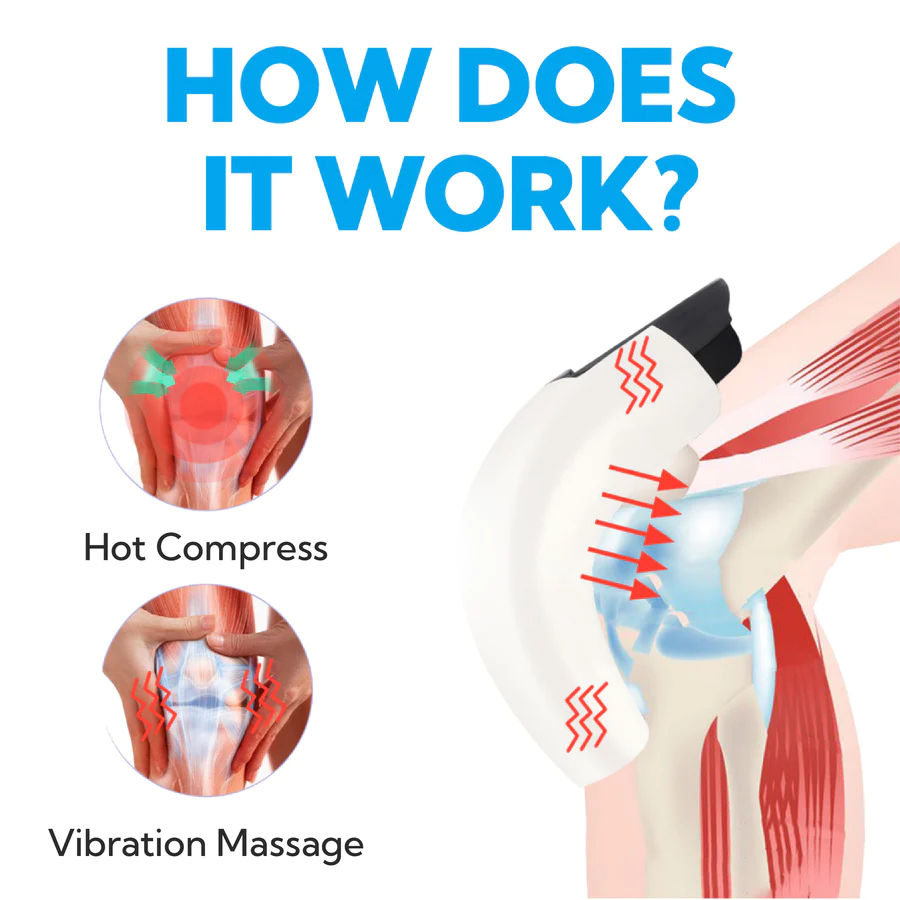
Chapter 3: How a Knee Massager Works and the Different Types Available?
In this chapter, we’ll take a closer look at how knee massagers work and the different types available on the market. You’ll learn about compression massagers, vibrating massagers, and heating massagers, and how each type works to relieve pain and promote recovery.
We’ll also discuss the benefits and drawbacks of each type of knee massager, so you can make an informed decision about which type is right for you. Whether you’re looking for a portable, on-the-go solution or a more advanced massager for home use, this chapter will help you find the right fit.
Knee pain is a common issue that affects a large portion of the population, and it can be caused by a range of factors, including injury, arthritis, and overuse. While medication and surgery are often recommended, many people prefer to try more natural, non-invasive methods of treatment first. One such method is using a knee massager, which can provide relief and promote healing.
How Does a Knee Massager Work?
A knee massager works by using pressure, vibration, or heat to stimulate the muscles and joints in the knee. This helps to increase blood flow and reduce pain and stiffness. The massage techniques used can vary depending on the type of massager, but the goal is always to provide a soothing, therapeutic experience.
Types of Knee Massagers
There are three main types of knee massagers: compression, vibrating, and heating. Each type works in a slightly different way, and choosing the right one for you will depend on your specific needs and preferences.
Compression Massagers
Compression massagers use airbags or other similar devices to apply pressure to the knee. The pressure is adjustable, and it can be increased or decreased as needed to achieve the desired level of massage intensity. Compression massagers are especially useful for those with knee pain caused by swelling or inflammation.
Vibrating Massagers
Vibrating massagers use vibration to stimulate the knee. This can help to increase circulation and reduce pain and stiffness. Vibrating massagers are often recommended for those with knee pain caused by injury or overuse, as they can help to loosen tight muscles and promote healing.
Heating Massagers
Heating massagers use heat to soothe the knee. The heat can be applied directly to the knee or it can be infused into the massager itself. Heating massagers are especially useful for those with knee pain caused by arthritis or other chronic conditions, as the heat can help to reduce inflammation and improve mobility.
Conclusion
Knee massagers are a non-invasive and natural way to provide relief and promote healing for those with knee pain. There are three main types of knee massagers, including compression, vibrating, and heating, and choosing the right one will depend on your specific needs and preferences. By using a knee massager, you can enjoy a comfortable and relaxing massage experience while also reducing pain and stiffness, promoting recovery, and improving overall well-being.
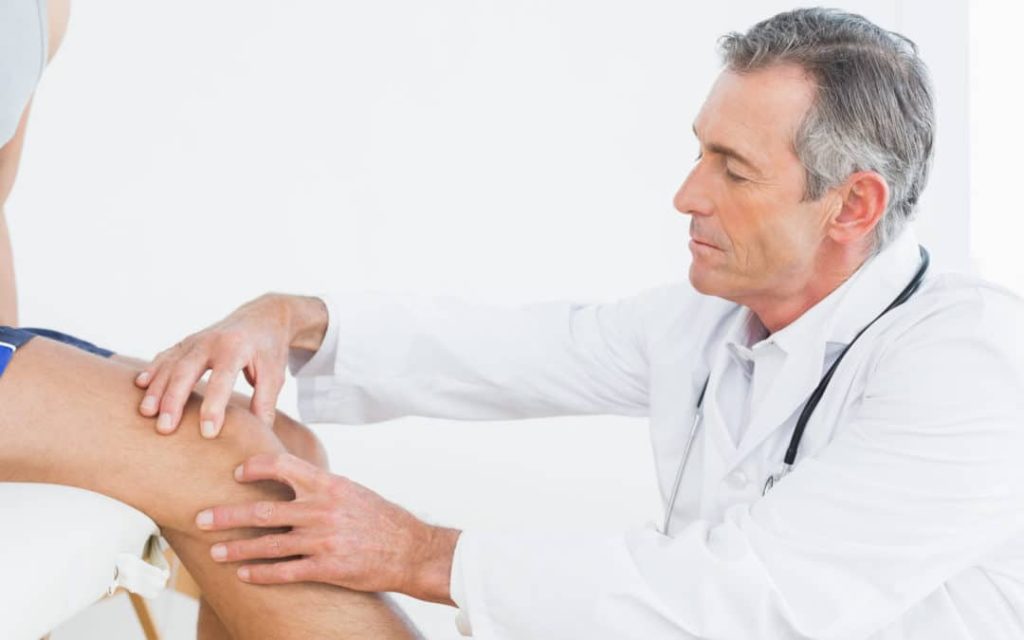
Chapter 4: The Importance of Proper Knee Alignment and Posture
In this chapter, we’ll delve into the importance of proper knee alignment and posture in the management of knee pain. We’ll discuss the common causes of improper alignment, such as poor posture and muscle imbalances, and explain how these factors can contribute to knee pain.
We’ll also cover exercises and stretches that can help improve knee alignment and posture, and how a knee massager can be used in conjunction with these exercises for maximum benefit. Whether you’re looking to prevent knee pain or manage an existing condition, this chapter will provide you with the tools you need to improve your knee health.
Maintaining proper knee alignment and posture is crucial for avoiding pain and injury, as well as for promoting overall mobility and stability. Whether you’re an athlete, a desk worker, or simply someone who wants to maintain good health, paying attention to your knees and the way you move and stand can have a significant impact on your quality of life.
In this article, we’ll explore the importance of proper knee alignment and posture and the ways in which they contribute to your overall well-being. We’ll also discuss common causes of knee pain and how to prevent it through proper alignment and posture techniques.
The Anatomy of the Knee Joint
The knee joint is one of the largest and most complex joints in the body, made up of three bones: the thighbone (femur), shinbone (tibia), and kneecap (patella). These bones are held together by a network of ligaments, tendons, and muscles, which work together to support the knee and allow for smooth and pain-free movement.
The Importance of Proper Alignment
Proper alignment of the knee joint is critical for avoiding pain and injury. When the knee is properly aligned, the weight of the body is distributed evenly across the joint, reducing the risk of wear and tear on the bones and tissues. This, in turn, helps to prevent knee pain, stiffness, and other common knee problems.
In addition, proper knee alignment also helps to improve stability and balance. This is particularly important for athletes and those who participate in high-impact sports, as it helps to reduce the risk of knee injuries and promote optimal performance.
The Benefits of Good Posture
Good posture is also essential for maintaining proper knee alignment and avoiding pain and injury. When you stand or sit with good posture, your knees are in a neutral position, which helps to distribute weight evenly across the joint and prevent excessive strain on the bones and tissues.
In addition, good posture also promotes overall health and wellness. When you stand or sit with good posture, your muscles are in a relaxed and natural position, reducing the risk of tension and pain in the back, neck, and other areas of the body. This, in turn, helps to improve your posture and prevent chronic pain and injury.
Common Causes of Knee Pain
Knee pain can be caused by a number of factors, including injury, overuse, and underlying health conditions. Some common causes of knee pain include:
- Arthritis: A degenerative joint disease that causes inflammation and pain in the knee joint.
- Tendinitis: Inflammation of the tendons that connect the muscles to the bones in the knee joint.
- Bursitis: Inflammation of the bursae, small fluid-filled sacs that cushion the knee joint.
- Dislocation: A knee injury that occurs when the bones in the joint are no longer aligned properly.
- Fractures: A break in one or more of the bones in the knee joint.
Prevention through Proper Alignment and Posture
To prevent knee pain and injury, it’s important to focus on maintaining proper alignment and posture in your daily activities. This may involve incorporating exercises and stretches into your routine to improve strength and flexibility in the knee joint, as well as paying attention to the way you stand, sit, and move.
Here are a few tips for maintaining proper knee alignment and posture:
- Stand with your feet hip-width apart, with your weight evenly distributed on both feet.
- Keep your knees relaxed and in a neutral position, without locking them
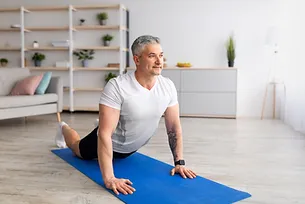
Chapter 5: The Role of Exercise and Stretching in Knee Pain Management
In this chapter, we’ll explore the role of exercise and stretching in the management of knee pain. We’ll discuss the benefits of these activities, including improved circulation, reduced muscle soreness, and increased joint mobility, and provide specific exercises and stretches that can help relieve knee pain.
We’ll also cover how a knee massager can be used in conjunction with exercise and stretching to enhance their benefits, and provide tips for incorporating these activities into your daily routine. Whether you’re an athlete or simply someone looking to maintain knee health, this chapter will provide you with the information you need to stay active and pain-free.
Knee pain is a common issue that affects individuals of all ages, whether it is due to injury, overuse, or underlying medical conditions. The good news is that exercise and stretching can play a significant role in managing knee pain and improving overall knee health.
Causes of Knee Pain
Knee pain can be caused by a variety of factors including:
- Arthritis
- Bursitis
- Tendinitis
- Meniscus tear
- Fracture
- Dislocation
- Ligament injury (ACL, MCL, LCL)
Benefits of Exercise and Stretching for Knee Pain Management
Regular exercise and stretching can help improve knee joint stability and flexibility, reduce inflammation and pain, and enhance overall knee function.
Strengthening Exercises
Strengthening exercises for the knee help to improve the strength of the muscles that support the knee, such as the quadriceps and hamstrings. This can help to take pressure off the knee joint, reduce pain and improve overall knee stability. Some examples of strengthening exercises for the knee include:
- Squats
- Lunges
- Leg press
- Hamstring curls
Stretching Exercises
Stretching exercises help to improve flexibility and range of motion in the knee, which can help to reduce pain and stiffness. Some examples of stretching exercises for the knee include:
- Hamstring stretch
- Quad stretch
- Calf stretch
- IT band stretch
Tips for Safe Exercise and Stretching
It is important to consult with a healthcare professional before starting a new exercise or stretching program, especially if you have a history of knee pain or injury. Here are some tips for safe exercise and stretching:
- Warm up before exercise with light cardio or dynamic stretching.
- Avoid exercises that put excessive stress on the knee joint, such as high-impact activities or deep squats.
- Gradually increase the intensity and duration of your exercise and stretching program over time.
- Stretch both before and after exercise to help improve flexibility and reduce muscle soreness.
Conclusion
Exercise and stretching can play a significant role in managing knee pain and improving overall knee health. Incorporating strengthening and stretching exercises into your routine, under the guidance of a healthcare professional, can help to reduce pain, improve stability and enhance overall knee function. Remember to warm up before exercise, listen to your body and gradually increase the intensity and duration of your exercise and stretching program over time.
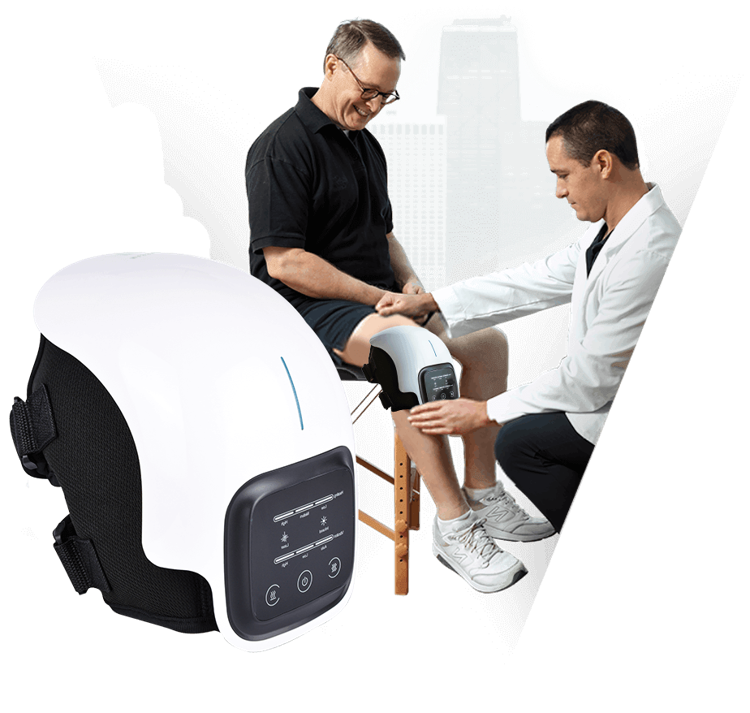
Chapter 6: The Benefits of Knee Massagers for Pre- and Post-Workout Recovery
In this chapter, we’ll focus on the benefits of using a knee massager before and after exercise. We’ll discuss how a knee massager can improve circulation, reduce muscle soreness, and help you recover more quickly from your workouts.
We’ll also provide tips for incorporating a knee massager into your pre- and post-workout routine, and explain how different types of knee massagers can be used to optimize recovery. Whether you’re a competitive athlete or simply someone looking to stay active, this chapter will help you get the most out of your workouts.
As an avid fitness enthusiast, you understand the importance of taking care of your body both during and after a workout. One often overlooked area that can greatly benefit from targeted attention is the knees. Whether you’re a runner, weightlifter, or engage in any other high-impact activity, your knees bear the brunt of the strain and stress. That’s why investing in a knee massager can be a game-changer for your workout routine.
The Benefits of Using a Knee Massager Pre-Workout
Using a knee massager before a workout can help prepare your knees for the demands of your routine. By increasing blood flow and loosening up tight muscles, a knee massager can help reduce your risk of injury and improve your overall performance. Additionally, many knee massagers come equipped with heat therapy options, which can help to warm up your joints and increase flexibility.
The Benefits of Using a Knee Massager Post-Workout
Perhaps even more important than pre-workout use, incorporating a knee massager into your post-workout routine can help speed up the recovery process and reduce pain and inflammation. The increased blood flow and release of tension in the muscles can help to flush out any built-up lactic acid and other metabolic waste. Furthermore, the heat therapy options can help to soothe sore muscles and promote relaxation.
Choosing the Right Knee Massager
With so many options on the market, it can be overwhelming to choose the right knee massager for your needs. It’s important to consider factors such as the intensity of the massage, the type of massage (such as vibration or air compression), and any additional features like heat therapy. It’s also important to consider the size and shape of the massager to ensure a comfortable fit around your knees.
Conclusion
Incorporating a knee massager into your fitness routine can have a profound impact on your workout performance and recovery. By taking the time to care for your knees, you’ll be able to push harder, recover faster, and ultimately achieve your fitness goals with less pain and discomfort. So why wait? Invest in a high-quality knee massager today and start feeling the benefits for yourself!
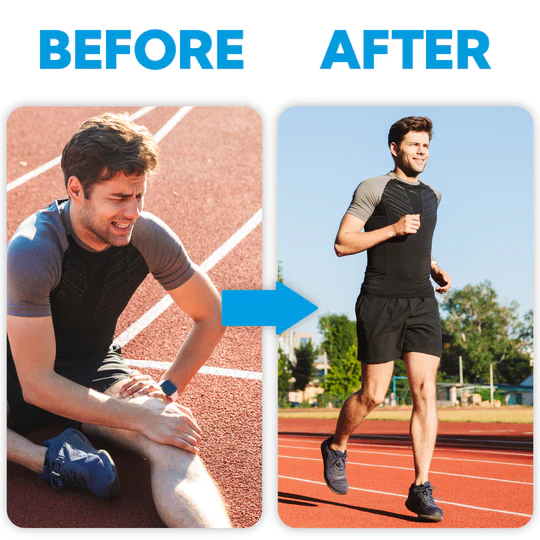
Chapter 7: The Effectiveness of Knee Massagers for Different Knee Conditions
In this chapter, we’ll delve into the effectiveness of knee massagers for specific knee conditions, such as osteoarthritis and patellofemoral pain syndrome. We’ll discuss the causes of these conditions and the ways in which a knee massager can help relieve pain and promote recovery.
We’ll also provide tips for choosing the right knee massager for your specific condition, and explain how a knee massager can be used in conjunction with other treatments, such as physical therapy and pain medication. Whether you’re looking to manage a chronic knee condition or simply maintain healthy knees, this chapter will provide you with the information you need.
Knee pain can greatly impact one’s daily activities and quality of life. Two common knee conditions, osteoarthritis and patellofemoral pain syndrome, affect a large population and can cause significant discomfort.
Osteoarthritis
Osteoarthritis is a degenerative joint disease that affects the cartilage in the knee joint. As the cartilage wears down, bones begin to rub against each other, causing pain, swelling and limited mobility. Risk factors for developing osteoarthritis include aging, obesity, and a history of knee injuries.
Patellofemoral Pain Syndrome
Patellofemoral pain syndrome is a condition that causes pain in the front of the knee, around the patella (knee cap). It is commonly caused by overuse, improper tracking of the knee cap, and muscle imbalances. Activities that put stress on the knee, such as running, jumping and squatting, can exacerbate the pain.
How Knee Massagers Can Help ?
Knee massagers work by providing targeted massage therapy to the knee joint, helping to improve circulation and reduce pain and swelling. The increased blood flow helps to speed up the healing process, while the massage helps to loosen tight muscles and relieve pressure on the knee joint.
There are several types of knee massagers available, including air compression knee massagers, vibration knee massagers, and heated knee massagers. Each type offers different benefits, so it’s important to choose the right one for your specific condition.
Tips for Choosing the Right Knee Massager
When choosing a knee massager, consider the following:
- Type of knee condition: Choose a knee massager that is specifically designed for your knee condition. For example, if you have osteoarthritis, a heated knee massager may provide the most relief.
- Adjustability: Make sure the knee massager can be adjusted to fit your knee comfortably and securely.
- Portability: Consider a knee massager that is easy to transport and use on-the-go, such as a compression knee massager.
- Durability: Look for a knee massager that is well-made and built to last.
In conclusion, knee massagers can provide significant relief for those suffering from knee conditions such as osteoarthritis and patellofemoral pain syndrome. By choosing the right type of knee massager and using it regularly, you can improve your knee health and get back to enjoying your daily activities.

Chapter 8: Tips for Incorporating Knee Massagers into Your Daily Routine
In this chapter, we’ll provide tips for incorporating a knee massager into your daily routine, regardless of your lifestyle. We’ll discuss how to use a knee massager for maximum benefit, including the best times of day to use it and how to use it in conjunction with other activities, such as exercise and stretching.
We’ll also provide tips for making the most of your knee massager, including how to clean and maintain it, and how to troubleshoot common problems. Whether you’re a busy professional or simply someone looking to maintain healthy knees, this chapter will provide you with the tools you need to make the most of your knee massager.
Knee massagers are an increasingly popular tool for people looking to relieve pain, improve circulation, and enhance overall well-being. Whether you have an active lifestyle or spend most of your time sitting at a desk, incorporating a knee massager into your daily routine can bring numerous benefits. In this article, we will outline tips for maximizing the use of your knee massager, no matter what your lifestyle entails.
The Best Times of Day to Use Your Knee Massager
The best time of day to use your knee massager will vary depending on your schedule and the type of knee pain you are experiencing. If you spend most of your day sitting, using your knee massager in the evening can help relieve any tension or discomfort that has built up throughout the day. If you are an active individual, incorporating knee massages into your post-workout routine can help alleviate pain and prevent injury.
Using Your Knee Massager in Conjunction with Other Activities
Incorporating your knee massager into other activities, such as exercise and stretching, can enhance the benefits you receive. For example, using your knee massager before a workout can warm up the muscles, while using it after a workout can aid in recovery. Stretching after using your knee massager can also help improve flexibility and range of motion.
Cleaning and Maintaining Your Knee Massager
Regular cleaning and maintenance of your knee massager is crucial for ensuring it continues to function properly and effectively. To clean your knee massager, simply wipe it down with a damp cloth and mild soap. It is also important to periodically check the straps and any other moving parts for any signs of wear and tear and replace them as necessary.
The Tools You Need to Make the Most of Your Knee Massager
While a knee massager is the main tool you will need, there are a few other items that can enhance your experience. For example, using a cushion or mat under your knee massager can provide added comfort, while a remote control can allow you to easily adjust the intensity and settings without interrupting your relaxation.
Conclusion
Incorporating a knee massager into your daily routine can bring numerous benefits, including pain relief, improved circulation, and overall well-being. By following these tips, you can ensure you are getting the most out of your knee massager and enjoying the many benefits it has to offer.
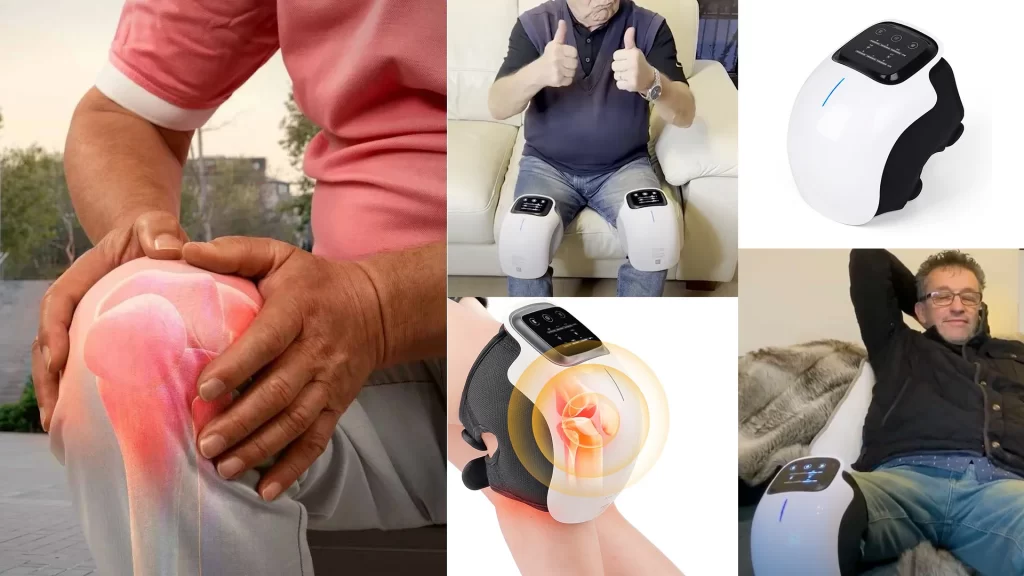
Chapter 9: Frequently Asked Questions about Knee Massagers
In this chapter, we’ll answer some of the most frequently asked questions about knee massagers, including questions about safety, effectiveness, and compatibility with other treatments. We’ll also provide answers to common questions about different types of knee massagers, such as compression massagers, vibrating massagers, and heating massagers.
Is a knee massager safe to use?
Yes, knee massagers are generally safe to use, as long as you follow the manufacturer’s instructions and precautions. However, it’s always a good idea to talk to your doctor before using a knee massager, especially if you have any underlying health conditions or are taking any medications that could interact with the massager.
Are knee massagers effective at relieving pain?
Knee massagers can be effective at relieving pain, as long as they are used correctly and for the right reasons. Massagers that use vibration, heat, or compression can help increase circulation, reduce inflammation, and relieve muscle tension. However, it’s important to keep in mind that knee massagers are not a cure for underlying medical conditions, and should be used in conjunction with other treatments recommended by your doctor.
The effectiveness of knee massagers for pain relief depends on several factors, including the type of pain and the individual’s specific condition. However, many people find that knee massagers can provide significant relief from knee pain and improve their overall mobility.
Some studies have shown that knee massagers can increase blood flow to the knee joint, which can help reduce pain and inflammation. They can also help to relieve muscle tension and improve range of motion, making it easier to perform everyday tasks.
It’s important to keep in mind that knee massagers are not a cure for knee pain and should not be used as a substitute for medical treatment. If you’re experiencing persistent knee pain, it’s always best to consult a doctor to determine the underlying cause and receive proper treatment.
Can Knee Massagers Be Used with Other Treatments?
Yes, knee massagers can be used in conjunction with other treatments, such as physical therapy and medications, to enhance their effectiveness. However, it’s always best to consult a doctor before combining treatments, as some interactions may not be appropriate or safe.
For example, certain medications may affect the skin’s sensitivity or affect blood flow to the knee joint, which can impact the effectiveness of a knee massager. By discussing your treatment plan with a doctor, you can ensure that you’re using your knee massager in the most effective and safe manner possible.
What Are the Different Types of Knee Massagers?
There are several different types of knee massagers available on the market, each designed to provide specific benefits and features. Some of the most common types of knee massagers include:
- Compression massagers: These massagers use air compression to apply pressure to the knee joint and surrounding muscles, helping to increase circulation and relieve pain.
- Vibrating massagers: These massagers use vibration to stimulate the knee joint and surrounding muscles, helping to relieve pain and improve mobility.
- Heating massagers: These massagers use heat therapy to increase blood flow to the knee joint and relieve pain. Some heating massagers also include massage features for added benefit.
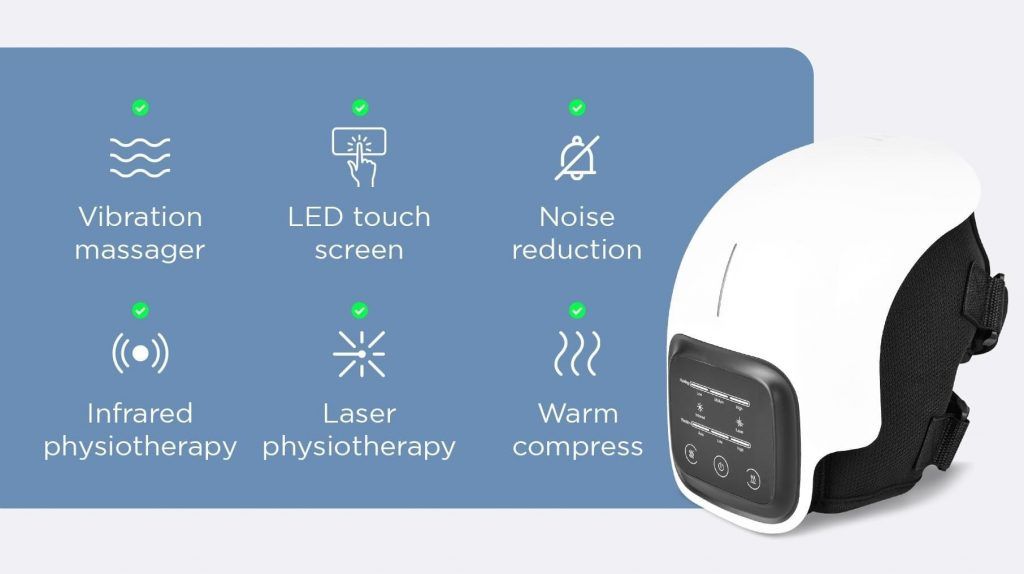
Chapter 10: Choosing the Right Knee Massager for Your Needs
In this chapter, we’ll help you choose the right knee massager for your needs. We’ll discuss the different factors to consider when making your decision, including your specific knee condition, lifestyle, and budget.
We’ll also provide recommendations for some of the best knee massagers on the market, based on our research and experience. Whether you’re looking for a portable solution or a more advanced massager for home use, this chapter will help you find the right fit.
Knee pain can greatly impact your daily activities and limit your mobility. Finding the right knee massager is crucial in providing relief and improving your knee condition. With a variety of options available in the market, choosing the right one for your needs can be overwhelming.
In this article, we will discuss the key factors you need to consider when selecting a knee massager, including your specific knee condition, lifestyle, and budget.
Specific Knee Condition
It is essential to identify the underlying cause of your knee pain before purchasing a knee massager. Some common knee conditions include osteoarthritis, rheumatoid arthritis, and bursitis.
If you have osteoarthritis, a knee massager with heating function may provide extra comfort and help relieve pain. On the other hand, if you have rheumatoid arthritis, a massager with a vibrating function may be more suitable.
In case of bursitis, a knee massager with adjustable straps can provide proper compression and help alleviate pain.
Lifestyle
Your lifestyle plays a significant role in determining the type of knee massager that would best suit your needs. For those with a sedentary lifestyle, a portable and lightweight massager would be ideal for use at home or at work. On the other hand, for those with an active lifestyle, a more durable and sturdy massager with adjustable straps would be a better option for on-the-go use.
Budget
Knee massagers can range from basic, inexpensive models to high-end, advanced devices. It is important to set a budget for your knee massager purchase and consider the features you need in a massager to best meet your needs.
Keep in mind that a more expensive massager may have additional features, such as heating and vibrating functions, that can enhance your therapy experience. However, a basic massager with adjustable straps may still provide adequate relief for your knee pain.
Other Considerations
- Ease of use: Look for a massager that is easy to operate and has clear instructions for use.
- Comfort: Choose a massager that provides comfort and does not cause discomfort or additional pain during use.
- Size: Consider the size of the massager to ensure it fits your knee comfortably and can be easily transported for on-the-go use.
- Brand reputation: Look for a well-known brand with a good reputation for producing high-quality products.
Conclusion
In conclusion, choosing the right knee massager for your needs involves considering several key factors, including your specific knee condition, lifestyle, budget, and additional considerations. Take the time to research and compare different models to find the one that best meets your needs. With the right knee massager, you can effectively manage knee pain and improve your overall knee health.
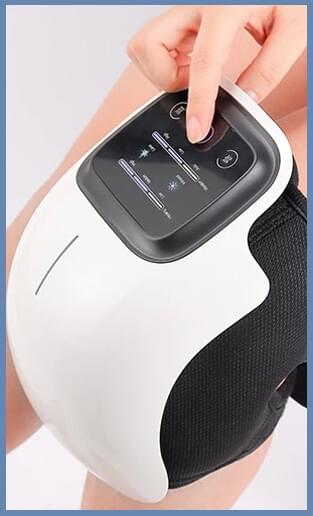
Chapter 11: Caring for Your Knee Massager: Cleaning and Maintenance
In this chapter, we’ll provide tips for caring for your knee massager, including how to clean it and maintain it for optimal performance. We’ll also discuss common problems and how to troubleshoot them, so you can get the most out of your knee massager for years to come.
Knee massagers are a popular and effective way to relieve knee pain, stiffness, and swelling. However, to ensure that your knee massager lasts for a long time and performs at its best, it is important to properly clean and maintain it. In this article, we will provide you with comprehensive cleaning and maintenance tips for your knee massager to help you keep it in top condition.
Cleaning Your Knee Massager
Cleaning your knee massager is crucial for keeping it hygienic and free from dirt and bacteria. Here are some steps to follow for effective cleaning:
- Unplug the massager and remove the pads.
- Wash the pads in warm soapy water and let them air dry.
- Wipe down the massager with a damp cloth and let it air dry.
- Do not immerse the massager in water or use any harsh cleaning products.
Maintaining Your Knee Massager
In addition to cleaning, there are a few maintenance tips you should follow to ensure that your knee massager lasts for a long time:
- Store the massager in a dry, cool place when not in use.
- Keep the massager away from moisture and direct sunlight.
- Check the pads regularly for any signs of wear or tear, and replace them if necessary.
- Do not overuse the massager, as this can cause damage to the motor and pads.

Chapter 12: The Future of Knee Pain Management through Technology and Innovation
In this chapter, we’ll explore the future of knee pain management through technology and innovation. We’ll discuss the latest advancements in knee massagers and other technology-based treatments, and how these advancements are reshaping the way we approach knee pain management.
From smart knee massagers that can track your progress to wearable devices that use electrical stimulation to reduce pain, we’ll explore the cutting-edge technology that is helping people manage knee pain more effectively.
In recent years, there have been significant advancements in knee pain management technology, including the development of smart knee massagers and wearable devices that use electrical stimulation to reduce pain. These new technologies are transforming the way we approach knee pain management and offering hope for those suffering from knee pain.
Smart Knee Massagers
Smart knee massagers are the latest advancement in knee massager technology. They are designed to track your progress and provide customized therapy based on your specific needs. Some of the features of smart knee massagers include:
- Real-time monitoring of pain levels and improvement over time
- Customizable massage programs based on your specific needs and preferences
- Integration with other wearable technology, such as fitness trackers, for a more holistic approach to knee pain management
- Access to online resources and support, such as videos and tips for exercises and stretches
Wearable Devices for Electrical Stimulation
Wearable devices that use electrical stimulation to reduce pain are another promising technology in the field of knee pain management. These devices work by using electrical currents to stimulate the muscles and reduce pain. Some of the benefits of using wearable devices for electrical stimulation include:
- Non-invasive and drug-free pain relief
- Portable and convenient, allowing for use at home or on the go
- Ability to target specific areas of the knee for maximum benefit
- Reduction in the need for pain medication, which can have side effects and long-term health consequences
Conclusion
In conclusion, the advancements in technology and innovation for knee pain management are offering hope and new options for those suffering from knee pain. From smart knee massagers that track progress to wearable devices that use electrical stimulation, there is a growing range of technology-based solutions available to help manage knee pain. It is important to work with your doctor or a physical therapist to determine the best approach for your specific needs and goals.
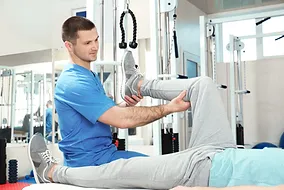
Chapter 13: Knee Massagers and Other Alternative Treatments for Knee Pain
In this chapter, we’ll take a look at knee massagers in the context of other alternative treatments for knee pain, such as acupuncture, chiropractic, and herbal remedies. We’ll discuss the pros and cons of each treatment, and how you can use them in combination with a knee massager for maximum benefit.
Knee pain is a common issue that can be caused by a variety of factors, including injury, arthritis, and overuse. While knee massagers are an effective and convenient way to alleviate knee pain, they are not the only treatment option available. In this article, we will explore some of the other alternative treatments for knee pain, such as acupuncture, chiropractic, and herbal remedies, and discuss how you can use them in combination with a knee massager for maximum benefit.
Acupuncture for Knee Pain
Acupuncture is an ancient Chinese medical treatment that involves the insertion of fine needles into specific points on the body to relieve pain and promote healing. When it comes to knee pain, acupuncture can help by improving circulation, reducing inflammation, and alleviating pain.
Pros:
- Acupuncture is a non-invasive treatment with no side effects.
- It has been proven to be effective for treating a variety of conditions, including knee pain.
- Acupuncture can help to improve overall health and well-being, not just knee pain.
Cons:
- It can be expensive, especially if you require multiple treatments.
- It may not be suitable for everyone, particularly those with a fear of needles.
Chiropractic for Knee Pain
Chiropractic is a form of alternative medicine that involves the manipulation of the spine and joints to alleviate pain and improve function. When it comes to knee pain, chiropractic can help by realigning the joints and improving the alignment of the legs.
Pros:
- Chiropractic is a non-invasive treatment that does not involve drugs or surgery.
- It can be effective for a variety of conditions, including knee pain.
- Chiropractic can help to improve overall health and well-being, not just knee pain.
Cons:
- It can be expensive, especially if you require multiple treatments.
- Some people may experience discomfort during the treatment.
Herbal Remedies for Knee Pain
Herbal remedies are a form of alternative medicine that involves the use of natural ingredients to treat various health conditions. For knee pain, there are several herbs that are commonly used, including ginger, turmeric, and willow bark. These herbs can help to reduce inflammation, alleviate pain, and promote healing.
Pros:
- Herbal remedies are generally safe and have few side effects.
- They are often more affordable than other alternative treatments.
- They can be used in combination with other treatments, including a knee massager, for maximum benefit.
Cons:
- The effectiveness of herbal remedies may vary from person to person.
- Some herbal remedies may interact with medications, so it is important to talk to your doctor before trying them.
Using a Knee Massager in Combination with Other Alternative Treatments
While knee massagers are effective on their own, they can also be used in combination with other alternative treatments, such as acupuncture, chiropractic, and herbal remedies, for maximum benefit. By combining different treatments, you can help to reduce inflammation, alleviate pain, and promote healing. However, it is important to talk to your doctor before starting any new treatment, to ensure that it is safe and suitable for you.
Conclusion
In conclusion, there are a variety of alternative treatments for knee pain, including acupuncture, chiropractic, and herbal remedies.
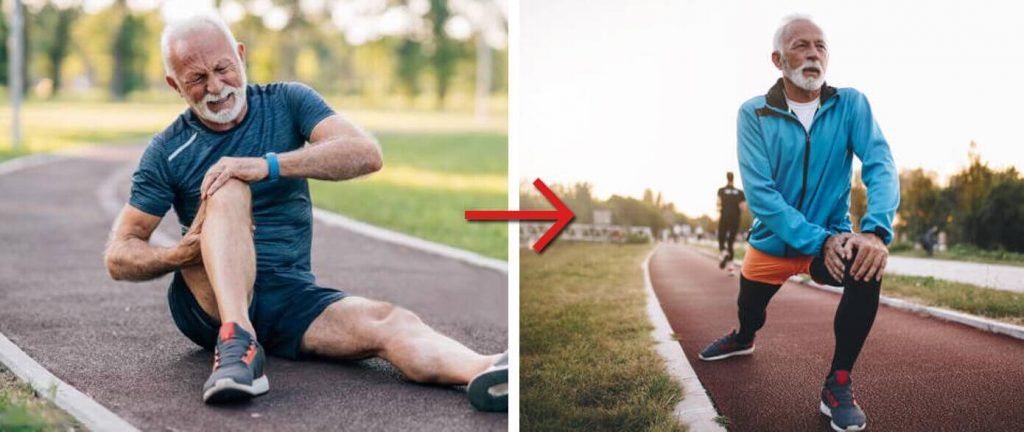
Chapter 14: The Importance of Knee Health and Prevention for a Healthy Lifestyle
In this chapter, we’ll discuss the importance of knee health and prevention in the context of leading a healthy lifestyle. We’ll provide tips for maintaining healthy knees, including exercises, stretches, and lifestyle changes that can help prevent knee pain and keep your knees healthy for life.
Your knees play a vital role in your overall health and well-being, as they support your body and help you move freely. However, knee pain and injuries can significantly impact your quality of life and limit your ability to engage in physical activity. To keep your knees healthy and prevent pain and injury, it is important to incorporate exercises, stretches, and lifestyle changes into your routine. In this article, we will discuss the importance of knee health and provide tips for maintaining healthy knees for life.
Exercise for Knee Health
Exercise is essential for maintaining strong and healthy knees. Regular physical activity can help to improve joint mobility, increase flexibility, and strengthen the muscles that support your knees. Some of the best exercises for knee health include:
- Brisk walking or hiking
- Cycling
- Swimming
- Yoga
- Strength training, especially for the quadriceps, hamstrings, and glutes
It is important to start slowly and gradually increase the intensity and duration of your exercise routine. It is also a good idea to talk to your doctor or a physical therapist before starting a new exercise program, to ensure that it is safe and appropriate for your needs.
Stretching for Knee Health
Stretching is another important aspect of maintaining healthy knees. Regular stretching can help to increase flexibility, reduce stiffness, and improve joint mobility. Some of the best stretches for knee health include:
- Hamstring stretch
- Calf stretch
- Quad stretch
- Butterfly stretch
- Figure-four stretch
It is important to hold each stretch for at least 15-30 seconds and repeat on both sides. Stretching should be done gradually and gently, without bouncing or forcing the joint beyond its natural range of motion.
Lifestyle Changes for Knee Health
In addition to exercise and stretching, there are also several lifestyle changes you can make to maintain healthy knees and prevent knee pain and injury. Some of these include:
- Maintaining a healthy weight to reduce stress on your knees
- Wearing supportive shoes with good arch support and cushioning
- Avoiding high-impact activities and sports that put excessive stress on your knees
- Using proper form and technique when lifting heavy objects
- Taking frequent breaks and stretching when sitting or standing for long periods of time
Conclusion
In conclusion, maintaining healthy knees is essential for overall health and well-being. By incorporating exercise, stretching, and lifestyle changes into your routine, you can help to prevent knee pain and injury and keep your knees healthy for life. It is important to talk to your doctor or a physical therapist for personalized advice and guidance on the best approach for maintaining healthy knees.

Chapter 15: Conclusion: The Power of Knee Massagers for Knee Pain Management
In this chapter, we’ll summarize the key points covered in this article and emphasize the power of knee massagers as a tool for knee pain management. Whether you’re looking to manage chronic knee pain, recover from an injury, or simply maintain healthy knees, we’ll provide guidance and resources to help you achieve your goals.
Knee pain is a common issue that affects people of all ages, and it can greatly impact your quality of life and ability to engage in physical activity. While there are many treatments available for knee pain, knee massagers can be a powerful tool for managing pain and promoting healing. In this article, we will discuss the benefits of using knee massagers for knee pain management and provide guidance and resources to help you achieve your goals.
The Benefits of Knee Massagers for Knee Pain Management
Knee massagers use various techniques, such as heat therapy, vibration, and massage, to provide relief from knee pain. Some of the benefits of using knee massagers include:
- Increased circulation to the knee area, which can help to reduce inflammation and promote healing
- Relief from pain, swelling, and stiffness
- Improved joint mobility and flexibility
- Relaxation of the muscles surrounding the knee
- Reduced stress and anxiety, which can also contribute to knee pain
Choosing the Right Knee Massager for Your Needs
When choosing a knee massager, it is important to consider your specific needs and preferences. Some factors to consider include:
- Type of massage (such as heat therapy, vibration, or compression)
- Intensity and speed settings
- Portability and convenience
- Ease of use
- Price
It is also important to talk to your doctor or a physical therapist before using a knee massager, to ensure that it is safe and appropriate for your needs.
Using Knee Massagers for Maximum Benefit
To achieve the best results from using a knee massager, it is important to use it regularly and consistently. You may also want to combine the use of a knee massager with other treatments and strategies, such as exercise, stretching, and lifestyle changes, for maximum benefit.
In conclusion, knee massagers can be a powerful tool for managing knee pain and promoting healing. By choosing the right knee massager for your needs and using it regularly and consistently, you can achieve significant benefits for your knee health and quality of life. Be sure to talk to your doctor or a physical therapist for personalized advice and guidance on the best approach for your specific needs.
We hope this article has provided you with the information and inspiration you need to take control of your knee pain and lead a healthy, active lifestyle. With the right knee massager and the right approach, you can say goodbye to knee pain and hello to a happier, healthier you.




